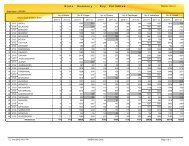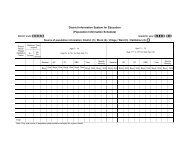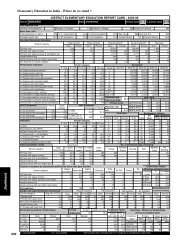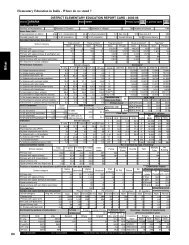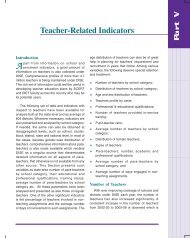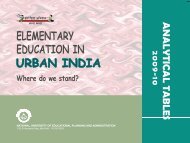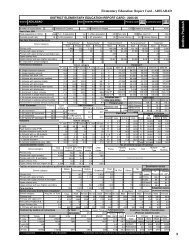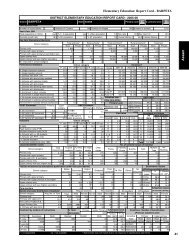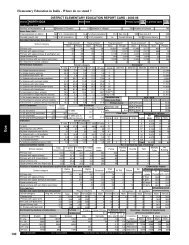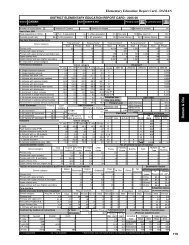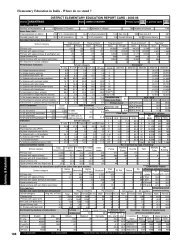Student Flow at Primary Level - DISE
Student Flow at Primary Level - DISE
Student Flow at Primary Level - DISE
- No tags were found...
Create successful ePaper yourself
Turn your PDF publications into a flip-book with our unique Google optimized e-Paper software.
48 <strong>Student</strong> <strong>Flow</strong> <strong>at</strong> <strong>Primary</strong> <strong>Level</strong>The drop-out r<strong>at</strong>e presented in Table 19 for cohort 2004-05 indic<strong>at</strong>es anaverage drop-out r<strong>at</strong>e of 9.96 percent in primary grades against 10.64percent during the previous cohort i.e. 2003-04. This shows th<strong>at</strong> duringthe intermediary years 2004-05 and 2005-06, as many as 9.96 percentchildren enrolled in Grades I to V dropped out from the system beforecompleting the primary grades as against 10.64 percent during intermediaryyears 2003-04 and 2004-05, and 11.27 percent during 2002-03 and 2003-04. The high incidence of drop-out in the primary grades is also evident inthe Apparent Survival R<strong>at</strong>es presented above (Table 8). An average dropoutr<strong>at</strong>e of 9.96 percent in primary grades during intermediary years 2004-05 and 2005-06 indirectly indic<strong>at</strong>es a very high drop-out r<strong>at</strong>e <strong>at</strong> primarylevel over a period of five year. Consequently, it also indic<strong>at</strong>es a lowretention r<strong>at</strong>e <strong>at</strong> the primary level of educ<strong>at</strong>ion. On the one hand, a fewst<strong>at</strong>es reported low average drop-out r<strong>at</strong>e than the average of all districts,while the other hand other st<strong>at</strong>es reported higher drop-out r<strong>at</strong>es.Arunachal Pradesh reported a high drop-out r<strong>at</strong>e of 15.93 percent followedby 14.90 percent in Rajasthan, 14.10 percent in Uttarakhand, 12.66 inHaryana, 11.55 percent in West Bengal, 11.53 percent in Uttar Pradeshand 11.36 percent in Bihar. Except Arunachal Pradesh, all these st<strong>at</strong>es arebig st<strong>at</strong>es and crucial for the country to <strong>at</strong>tain the st<strong>at</strong>us of universalretention <strong>at</strong> the primary level of educ<strong>at</strong>ion. Kerala with 1.34 percent,Tamil Nadu with 2.00 percent and Himachal Pradesh with 2.85 percentdrop-out r<strong>at</strong>e have almost achieved the goal of universal retention <strong>at</strong>primary level. Experience of these st<strong>at</strong>es may be useful to other st<strong>at</strong>es ashow they have achieved it and also the str<strong>at</strong>egies adopted by them to<strong>at</strong>tain this st<strong>at</strong>ure.A cursory look <strong>at</strong> grade-specific drop-out r<strong>at</strong>es indic<strong>at</strong>es th<strong>at</strong> about 11.89percent children enrolled in Grade I in 2004-05 dropped out before thecompletion of Grade I between 2004-05 and 2005-06, compared to 12.17percent during the previous cohort. In many st<strong>at</strong>es, drop-out r<strong>at</strong>e inGrade I is noticed to be alarmingly high, and it needs careful examin<strong>at</strong>ionand appropri<strong>at</strong>e str<strong>at</strong>egies to check it. Among the major st<strong>at</strong>es, Rajasthanreported a very high (20.63 percent compared to 24.97 percent duringprevious year) drop-out r<strong>at</strong>e in Grade I. Bihar (15.22 percent against 14.44percent in previous year), Jammu and Kashmir (19.24 percent), Jharkhand(27.55 percent), Meghalaya (33.29 percent), Uttarakhand (16.61 percent),Uttar Pradesh (10.68 percent) and West Bengal (16.29 percent) alsoreported a very high drop-out r<strong>at</strong>e in Grade I. Unlike Grade I, Grades II, IIIand IV have lower drop-out r<strong>at</strong>es and the same varies between 5.49 to6.88 percent. However, a few st<strong>at</strong>es, such as Meghalaya (Grades II, III and




